
 The newsletter of NASA's Radio JOVE Project
The newsletter of NASA's Radio JOVE Project"Solar and Planetary Radio Astronomy for Schools"

 The newsletter of NASA's Radio JOVE Project
The newsletter of NASA's Radio JOVE Project

Adityaa Divyadarshan Purohit and Riddhi Divyadarsha Purohit of Vadodara, Gujarat inIndia received a grant from the Society of Amateur Radio Astronomers (SARA) for a Radio Jove system. The sisters plan to enter their project in a science fair in January. Upon completion, they will share the unit with a group of more than 50 students who have an interest in astronomy. According to Adityaa and Riddhi this is the first Radio Jove system in their state of Gujarat.
The young ladies have the support of their father Divyadarshan Purohit who is a cosmologist working with a local planetarium. A local ham radio expert, Mr. Raju Sheth, who is an E & C Engineer and has a radio communication business, assisted in installing the antennas this summer after the monsoons.
The group had a very successful open house with students, teachers and media coverage. They are now learning how to interpret what they are observing and have been challenged with a unique problem, how to keep monkeys off the dual dipole antenna without harming the monkeys or the antenna.
The family has great enthusiasm for Radio Jove and we are looking forward to reports of their observations in India.
About 3,000 people attended the Starry Night Event held at the Museum of Natural History in Gainesville, Florida on September 25, 2009 between 5 and 10 PM. The event was organized by the Museum in collaboration with the Univ. of Florida Astronomy Department, the Florida Space Grant Consortium, the Alachua Astronomy Club and Santa Fe College. This was the biggest event in North Central Florida in celebration of the International Year of Astronomy 2009. Funding for the event was provided by the FSGC, the GE Foundation and the Museum.
There were several attractions during the event. Former astronaut, Captain Winston Scott, gave two talks. Additional short talks were given by faculty members of the UF Astronomy Dept. on topics such as Black Holes, Dark Matter, Extrasolar Planets and Star Formation. A Galileo-scope workshop was held for about 80 students and people from the general public on how to build this simple telescope. About 15 telescopes provided by the Alachua Astronomy Club and the Astronomy Dept. were set-up outside for public viewing. The Sun, Moon, Jupiter, Ring nebula and some globular clusters were the main attractions for the evening.
The Radio JOVE project was also present during the event. A table with the theme “Discover the Invisible Universe” was set up outside by Wes Greenman, Masafumi Imai and Francisco Reyes in the same area as the optical telescopes. The display included one Radio Jove dipole antenna, an RJ receiver, a laptop computer, a flat screen monitor and an audio system. SkyPipe was displayed on the monitors so the public could both see and hear the galactic background. The cover to the Radio Jove receiver was removed so the pubic could see how the receiver looked when properly assembled. A Jove parts kit was displayed as a comparison to see the receiver “before and after” assembly. Some audio samples of L-bursts and S-bursts were played for interested parties.
A few weeks prior to the event, Dick Flagg, Wes and Francisco set up the same equipment to check for power line or other types of interference. We were surprised that we could not detect any interference at the site even though it is located close to several buildings around the cultural plaza and also close to a high voltage power line. The quick calibration of the noise level using an HP 461 noise generator agreed with the level expected from the galactic background at that time.
Many visitors were interested and surprised by the fact that they could listen to the sound of the low frequency radio emission emitted by the Milky Way. Unfortunately no solar bursts or Jupiter bursts were detected during the event. There were no predicted Io related storms at that time. After many days of no sunspots, finally sunspots 1026 and 1027 were visible on that day and they were shown in the optical telescopes. About 110 RJ brochures were distributed during the event.
In the week previous to the event, Reyes and other members of the UF Astronomy Dept. visited the High Spring Community School to advertise the event, build a few Galileo-scopes for the students and give talks about Galileo, his observations and discovery and to introduce them to the Radio JOVE educational program.
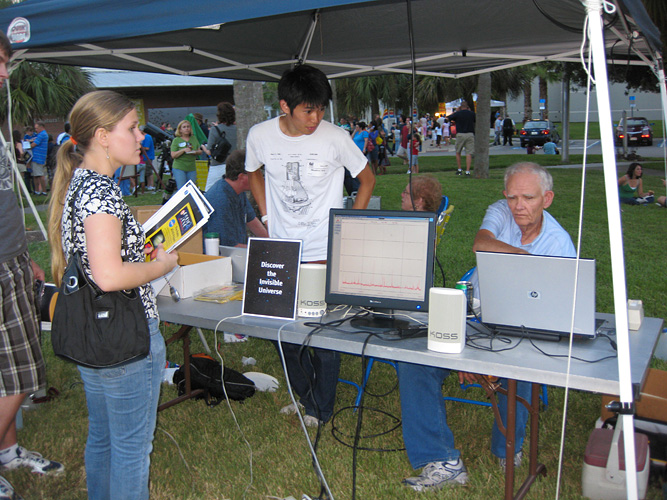
On October 11, John Avellone volunteered at the NRAO Open House at the National Radio Astronomy Observatory Headquarters in Charlottesville, Virginia. John demonstrated several types of radio astronomy systems including:
A colleague brought his laptop with Skypipe, but the display didn't show up well in the bright sunlight so they ran the radios with audio output instead.
They also displayed "real data" SkyPipe charts for previous RJ collections (Sun/galactic transits/Jovian noise storms) as well as for FM and CH-6 TV radio meteors, the HAARP moonbounce experiment, and LF NAA 24 hr signal variations. John also had a homemade replica of Galileo's 1610 model 20X telescope set up and aimed at a brick wall.
Attendance was fairly good. Lots of young families, some teachers, some adults collecting information for teachers, a number of curious older kids/young teenagers, and one self-identified writer. The visitors who stopped by seemed interested and were enjoyable to talk with.
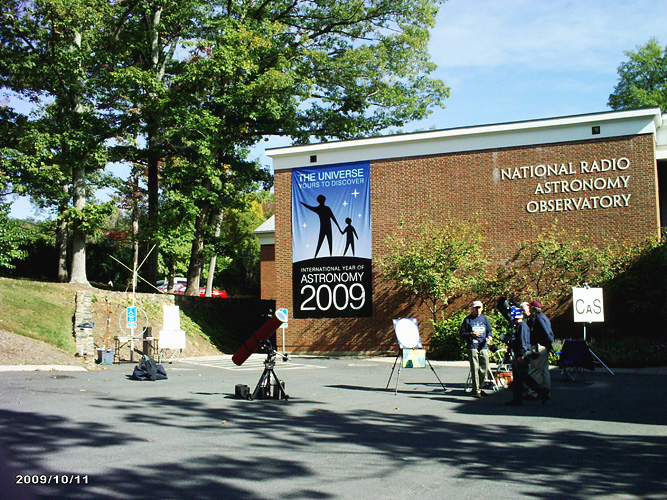
In 2011 NASA plans to launch a "New Horizons" mission to Jupiter called Juno. (http://www.nasa.gov/mission_pages/juno/main/index.html) Juno is intended to make measurements that are important to the understanding of the origin and evolution of Jupiter, and from that, gain knowledge about the origin and evolution of the solar system as a whole. Radio astronomy measurements constitute a very important part of this mission. The Radio JOVE project, in partnership with the Goldstone Apple Valley Radio Telescope (GAVRT) group, will be participating in the education and outreach activities associated with the mission.
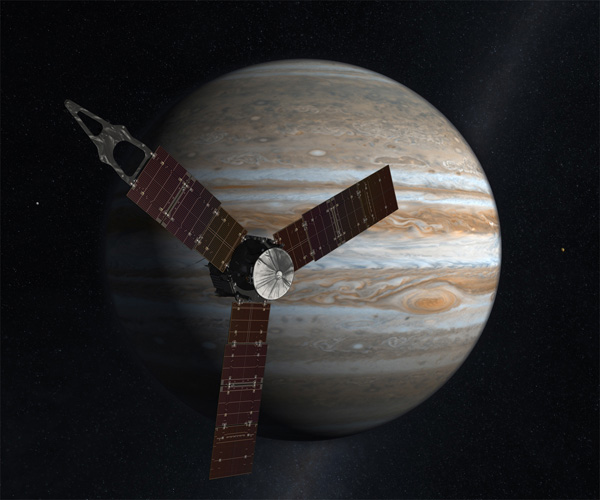
GAVRT is a partnership involving NASA, the Jet Propulsion Laboratory (JPL), and The Lewis Center for Educational Research (LCER) in Apple Valley, California in which students and teachers can control a 34-meter radio telescope to make measurements that contribute both to interactive learning and to scientific discovery. For detailed information see http://www.lewiscenter.org/gavrt/
There has already been a joint GAVRT/Radio JOVE "Education Summit" meeting to develop lesson plans with content relevant to the study of Jupiter's magnetosphere. These lesson plans will be available to educators from websites, but they will also be used as a part of joint GAVRT/Radio JOVE week-long educator workshops. These workshops will begin in 2010 and continue periodically for several years after that. If you are interested in these workshops/training sessions please link to: http://www.lewiscenter.org/gavrt/opportunities.php
Radio Jove team member, Whitham Reeve of Anchorage, Alaska, recently published a two-part article on Listening to Jupiter's Radio Storms in the September and October 2009 issues of RadioUser Magazine. His article gave lots of useful details on what Jupiter radio emissions are like, and how and when to observe them. Congratulations Whit!
The Society of Amateur Radio Astronomers (SARA - http://www.radio-astronomy.org/) meets annually at the National Radio Astronomy Observatory (NRAO) in Green Bank, West Virginia. The dates for the meeting in 2010 have been set for July 4 - 7. The theme for this year's conference is "Radio Astronomy in Decametric Frequencies", and we are very happy to announce that the Radio JOVE project staff have been invited to give a keynote address at this meeting. We hope to have several of our staff presenting this address and intend to set up a standard dual dipole system and give demonstrations of some of the latest developments within the project. Others are invited to present as well and it would be most welcome to have other Radio JOVE observers presenting their experiences. As noted by the organizers, the presentations do not have to be limited to decametric frequencies. For more details see the SARA Conference website: http://www.radio-astronomy.org/node/110. We hope to see many of our friends there and have a great discussion about the joys of radio astronomy.
Radio JOVE staff have long been associated with SARA. One of the first tests of the Radio JOVE RJ1 receiver was a connection to the replica of the original Jansky telescope on the grounds of NRAO during a SARA meeting. We were able to successfully observe Jupiter in this way early on a frosty morning in West Virginia. For more information on this see the articles in the Sept. 1999 issue of the JOVE Bulletin (http://radiojove.gsfc.nasa.gov/library/newsletters/1999Sep/1999Sep.txt) Perhaps we will have the opportunity to repeat this experience. Come and join the fun!!
President Tom Crowley of the Society of Amateur Radio Astronomers (SARA) announced a student grant program for aspiring radio astronomers. “The Officers and Board of Directors felt strongly that we need to encourage young people in the study of science and radio astronomy and the grant program was established to help students fund their projects.” He further explained “We have set aside $3,000.00 this year for students in grades 5 thru college. An application is posted at our web site www.radio-astronomy.org.”
SARA membership income and sale of items from the SARA Store help to fund the student grant program. If you would like to join or find out more about SARA visit our webpage.
SARA is an international society of dedicated enthusiasts who teach, learn, trade technical information, and do their own observations of the radio sky. This organization is a scientific, non-profit group founded for the sole purpose of supporting amateur radio astronomy. SARA was organized in 1981, and today has hundreds of members worldwide. The group consists of optical astronomers, ham radio operators, engineers, teachers and non-technical persons. Many of our members are new to the field, and membership is extended to all who have an interest in radio astronomy.
On July 4, 2009, Radio Jove participants Mihai Dumitru EDRO, Steve McCauley ACkRO, Whitham Reeve and Victor Herrero were able to record and analyze 8 Type III Solar bursts, that occurred between 1 and 3 hours UT. The Sun's activity has been very low this year and this was a very pleasant achievement for all of us.
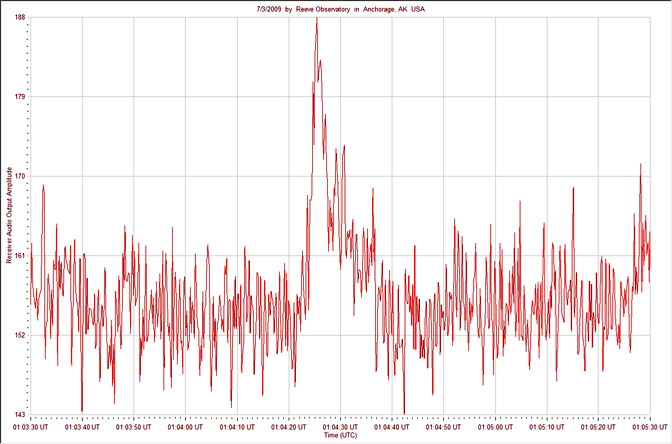
The timing correlation of the observations at 20 MHz, in Australia and Alaska, and the STEREO/WAVES spectra at 16 MHz, from solar orbit (see STEREO/WAVES Daily Spectrogram Plot), was nearly at the time resolution of the SWAVES daily plots (about 1 minute). The Culgoora Observatory (near Narrabri, New South Wales, Australia) daily spectrogram plots also shows at least 8 type III bursts in the 18 to 180 MHz band.
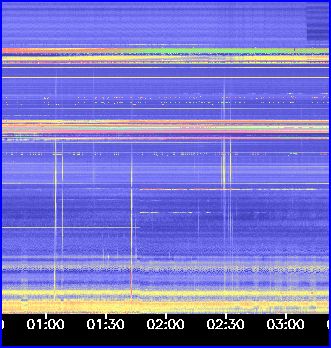
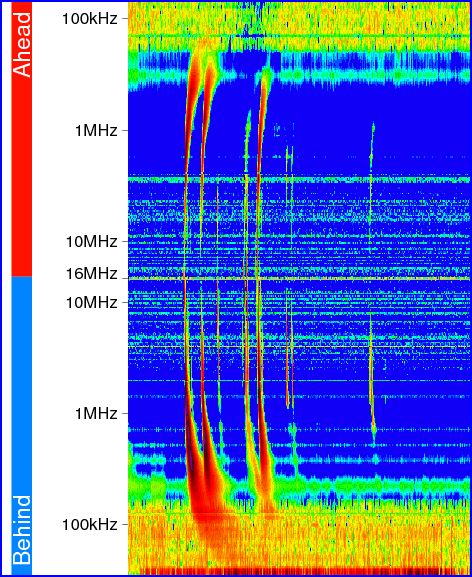
Our many thanks to the STEREO/WAVES Instrument Team.
The 2009 Jupiter observing season is rapidly coming to a close. The season has no official ending, but November 30 is the date set for this year. This date is based on Jupiter's opposition date, where opposition is the date on which Jupiter is exactly opposite the Sun in the sky as viewed from Earth (i.e. on this date the planet will transit at local midnight). This date was August 14, 2009. We generally observe Jupiter for +/- 3-4 months from this date. However, the length of the season depends on several factors: the solar cycle, Jupiter's elevation angle, antenna type, local conditions, etc.
Currently, solar activity is very, very low; therefore, observers are able to receive Jupiter signals as Jupiter's position in the sky moves closer to the Sun. The point when Jupiter and the Sun share the same position in the sky is called a conjunction. Around the time of conjunction Jupiter is above the horizon only during the daytime and Earth's ionosphere absorbs the radio signals from Jupiter. The next conjunction is February 28, 2010.
The type of antenna used can also affect the length of the observing season. The Radio JOVE dual dipole antenna is generally good to observe Jupiter for about 6-8 months depending on your latitude and Jupiter's elevation (see below). Other more directional type antennas allow one to observe Jupiter even longer each year. The best way to determine when Jupiter is visible, and when are the best times to observe Jupiter for radio events, is by using the Radio-Jupiter Pro 3 software (Figure 1).

The Jupiter observing season will be better in 2010 for northern hemisphere observers because Jupiter's elevation angle is increasing. Jupiter's maximum elevation angle changes on a near 12-year cycle due to Jupiter's orbit. Jupiter reached it's maximum southern position in 2008 and it will reach its maximum northern position in 2014. These details are found in the Radio JOVE Antenna Construction manual; many more details are found in Chapter 3 of Dick Flagg's Listening to Jupiter, 2nd Ed., 2005.
The 2010 Jupiter opposition date is September 21; therefore the Jupiter observing season will begin about May 21, 2010. Stay tuned for updates next year and we will make an announcement for you to join us. In the meantime the Sun is always a good target for observations.
In the June 2008 issue of the Jove Bulletin we discussed antenna temperature. This measure of received signal strength is now being used by several Radio Jove observatories.
Most of us are using Jim Sky’s excellent Radio SkyPipe software to record and display signal strength data. The signal trace on the SkyPipe screen can be adjusted with the Jove receiver volume control and also the software volume control in Windows. By changing these gain settings, the trace can be moved up or down and compressed or expanded. However, there is no absolute reference point. The SkyPipe vertical scale units (SkyPipe units – SPU) are not engineering units like volts, watts, or degrees.
By converting SPU to absolute antenna temperature you can:
A calibrated noise source is necessary in order to convert SPU to antenna temperature. If you are using a Jove receiver, the noise source need only provide a single reference temperature. Other receiver types (those with a diode detector) require a multi-level noise source.
The calibration wizard in Radio SkyPipe 2 does all the computational work for the Jove receiver and one-step noise source. It nulls out soundcard noise and uses the calibrated reference temperature signal to perform the conversion to antenna temperature. By using information about your antenna type and coax cable SkyPipe 2 references the measured antenna temperature to the antenna terminals.
This means that signals displayed on SkyPipe can be directly compared with signals from other observatories – even if they use different gain settings or different lengths of coax between their antenna and receiver. Furthermore you will know the background temperature at your receiving site – how radio quiet or noisy it is in comparison to an ideal galactic background temperature of around 40,000 kelvins.
The new RF-2080 C/F, a single temperature, calibrated, noise source is described in an accompanying article.
The RF-2080 C/F is designed for use with the Jove receiver and Radio SkyPipe 2. This 25 thousand degree calibrated noise source is installed between the antenna and receiver.
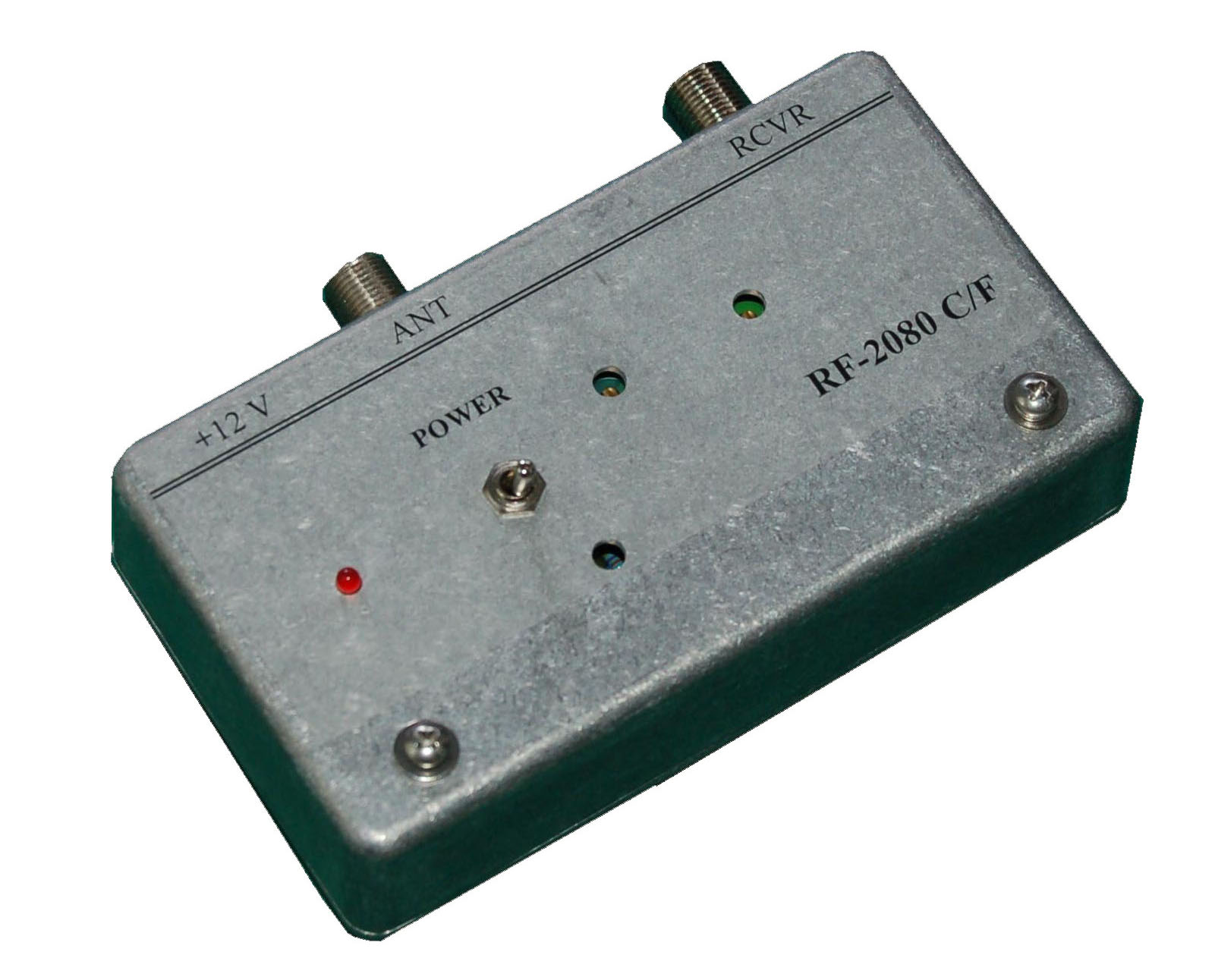
A single toggle switch controls power and also selects the source of the signal being routed to the receiver. When the 2080 is OFF the antenna is connected to the receiver. When it is ON the noise source is connected to the receiver.
The unit includes a 20.1 MHz bandpass filter which will reduce or eliminate interference to the Jove receiver caused by strong international broadcast stations.
The 2080 is only available as an assembled, tested, and calibrated unit. It is equipped with F-connectors and supplied with a short F to F coax jumper for connection to the Jove receiver. The RF-2080 C/F requires +12 to +15 vdc at 50 ma. Power can be obtained from the Jove receiver power supply or from a separate dedicated supply. The price is $80 (no power supply included) – see the Jove website ordering page for details (after December 1, 2009).
Other noise calibrators are available from RF Associates. These include the RF-2080 C (same as the RF-2080 C/F but no filter for $60), the RF-2080 C/F with BNC connectors, and the RF-2050S (a multi-temperature calibrator). For details contact rf@ hawaii.rr.com.
The JOVE Bulletin is published twice a year. It is a free service of the Radio JOVE Project. We hope you will find it of value. Back issues are available on the Radio JOVE Project Web site, http://radiojove.gsfc.nasa.gov/
For assistance or information send inquiries to:
or
